Adventurous souls and water lovers alike are bound to fall in love with scuba diving the moment they try it. There is nothing compared to the relaxation of being among sea-dwelling creatures, alone with your thoughts in almost complete silence. It’s exhilarating to explore the world from underwater, and many who take up this hobby can’t seem to get enough of it.
Scuba diving, however exciting, is a costly hobby. Before you embark upon a journey underwater, it helps to know upfront the various expenses you will need to incur. Of course, there are ways to cut costs safely. More on that later. For now, here’s a detailed breakdown of the expenses associated with scuba diving.
Initial Costs
As with any sport or hobby that requires the purchase of special equipment, you can expect to incur some expenses at the start. Some of these costs depend on the quality of the equipment you intend to use, but most of these are necessary purchases for scuba diving.
Certification
 Every country has different regulations set to restrict scuba divers from going too deep underwater without proper certification. Three of the main international certifications for scuba diving are PADI (Professional Associate of Diving Instructors), SDI (Scuba Diving International), and NAUI (National Association of Underwater Instructors). They each have several programs training divers, and each certification teaches divers to dive up to a specified depth. The cost of obtaining a scuba certification is around $200 for the theoretical exam (can be online) and another $200 for the practical diving course and certification.
Every country has different regulations set to restrict scuba divers from going too deep underwater without proper certification. Three of the main international certifications for scuba diving are PADI (Professional Associate of Diving Instructors), SDI (Scuba Diving International), and NAUI (National Association of Underwater Instructors). They each have several programs training divers, and each certification teaches divers to dive up to a specified depth. The cost of obtaining a scuba certification is around $200 for the theoretical exam (can be online) and another $200 for the practical diving course and certification.
Of course, you could forgo certification altogether, but that would mean you are less equipped to scuba dive and will only be able to dive at the basic level. Besides the safety reasons, there is much more to explore at deeper sea levels, so consider spending the extra money for more certification.
Equipment
Scuba diving equipment comes in various qualities and types, and it is entirely possible (and safe) to go diving with rented equipment. However, keep in mind that the long-term cost of paying for rented scuba gear can quickly add up if you are planning on going scuba diving often.
The best option is to start with rented equipment, and if you find the activity enjoyable enough to dive frequently, you can think of purchasing your own scuba gear. The following are all the scuba diving equipment you will need, from the most expensive to the cheapest.
Diving Regulator
You probably recognize this as a mouthpiece with a connected hose to breathe through. 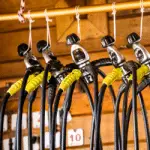 This is the most crucial part of your diving gear because it delivers air to you when you are underwater. It brings down the air pressure from the tank to keep the diver breathing comfortably.
This is the most crucial part of your diving gear because it delivers air to you when you are underwater. It brings down the air pressure from the tank to keep the diver breathing comfortably.
A variety of regulators models are currently available, with higher-end models made specifically for some types of diving. There are cold water regulators and normal water regulators. Some manufacturers make travel-size diving regulators for people who travel frequently. Beginner divers can make use of any type, but if you’re planning on more complex dives, you might need to invest in a premium model.
Price Range: $100 – $1600
Dive Watch
It is a small watertight computer that provides real-time information about your dive. The information is shown on a dive watch (aka dive computer) is critical to avoid decompression and for decompression when needed. 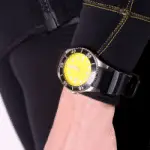 Other information shown on a dive watch includes the duration and depth of the dive and water temperature and direction.
Other information shown on a dive watch includes the duration and depth of the dive and water temperature and direction.
It is essential to use a dive watch when diving and to learn its proper use. Prices for dive watches vary greatly, according to the extra (non-essential) features that may be added and how user-friendly it is.
Price Range: $200 – $1200
Buoyancy Compensator (aka BCD)
A BCD goes by many names, which is normal because, without this device, scuba diving would not be possible. The jack-like device enables divers to control their buoyancy (floating or sinking) underwater or on the surface.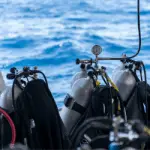
To further elaborate, the device consists of an inflatable bladder that can be inflated or deflated to give the diver neutral buoyancy when underwater. Neutral buoyancy means the diver is neither sinking nor floating, which is important when trying to stay steady underwater. Positive buoyancy (floating) can be established using a BCD as well.
Inflating a BCD’s bladder can be done orally or with the help of a manual or automated pump. Some higher-end models have extra features to optimize comfort or are more lightweight than others. Even the cheapest option is still pricey, but this piece of equipment is essential for scuba diving.
Price Range: $350 -$1000
Wetsuit
While some scuba divers choose to forgo wearing a wetsuit for warmer waters, they are a minority. 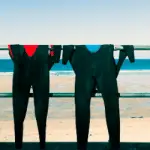 Wetsuits are important in providing protection from exposure by providing warmth. Hypothermia is a risk when scuba diving for prolonged periods, so diving instructors usually recommend wearing a wetsuit. It also protects against stings from marine life or sharp rocks.
Wetsuits are important in providing protection from exposure by providing warmth. Hypothermia is a risk when scuba diving for prolonged periods, so diving instructors usually recommend wearing a wetsuit. It also protects against stings from marine life or sharp rocks.
Wetsuits come in a variety of styles and range in thickness from 1mm to 7mm (thicker material provides extra insulation for more warmth). Materials used include lycra (cheaper) and neoprene (more expensive).
Price Range: $50 – $500
Fins
Scuba fins protect your feet from sharp rocks on the sea bed and help you move around more freely underwater. 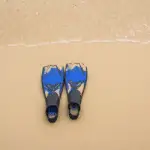 They generally come in two designs: paddle and split. The former allows faster gliding through the water, whereas split fins reduce turbulence and give your kicks more efficiency. Price variations depend on design, adjustable heels, the material used, and many other factors.
They generally come in two designs: paddle and split. The former allows faster gliding through the water, whereas split fins reduce turbulence and give your kicks more efficiency. Price variations depend on design, adjustable heels, the material used, and many other factors.
Price Range: $75 – $200
Mask
Seeing underwater is not possible without goggles because water refracts light differently than air. 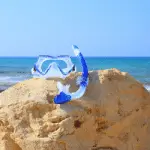 A scuba mask allows divers to see clearly, and must also cover the nose with a watertight fit. When descending from water, scuba divers need to equalize pressure inside the mask with the mask’s pressure to avoid a condition called mask squeeze. Breathing out through the nose helps achieve this equilibrium.
A scuba mask allows divers to see clearly, and must also cover the nose with a watertight fit. When descending from water, scuba divers need to equalize pressure inside the mask with the mask’s pressure to avoid a condition called mask squeeze. Breathing out through the nose helps achieve this equilibrium.
Price Range: $50 – $200
Snorkel
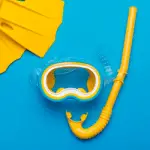 This is an optional piece of scuba equipment that allows for breathing surface air when your head is submerged. There are many reasons to get a snorkel, but it is not necessary for scuba diving.
This is an optional piece of scuba equipment that allows for breathing surface air when your head is submerged. There are many reasons to get a snorkel, but it is not necessary for scuba diving.
Price range: $25 – $100
Ongoing Costs
Whether you choose to rent your diving gear or not, you may need to incur some additional expenses every time you dive. Diving spots around the world have a wide range of prices depending on the local currency exchange rate and many other factors. If you plan on renting your equipment, ask ahead whether the price includes rental and any other details.
Prices for dive spots in the United States range from $50 to $300 per person and usually do not include the cost of renting scuba gear.
International dive spots range from $70 to $200 and usually come as a package that includes equipment rental (if needed).
Summary
Certification costs around $400, and the cheapest equipment (without snorkel) comes up to $825. The cheapest diving spots are $50 to $70, depending on whether you are diving locally or internationally. Of course, these prices can easily go up by thousands of dollars.
